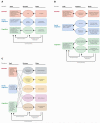Large-scale brain networks in affective and social neuroscience: towards an integrative functional architecture of the brain
- PMID: 23352202
- PMCID: PMC4119963
- DOI: 10.1016/j.conb.2012.12.012
Large-scale brain networks in affective and social neuroscience: towards an integrative functional architecture of the brain
Abstract
Understanding how a human brain creates a human mind ultimately depends on mapping psychological categories and concepts to physical measurements of neural response. Although it has long been assumed that emotional, social, and cognitive phenomena are realized in the operations of separate brain regions or brain networks, we demonstrate that it is possible to understand the body of neuroimaging evidence using a framework that relies on domain general, distributed structure-function mappings. We review current research in affective and social neuroscience and argue that the emerging science of large-scale intrinsic brain networks provides a coherent framework for a domain-general functional architecture of the human brain.
Copyright © 2013 Elsevier Ltd. All rights reserved.
Figures


References
-
- Fodor JA. The modularity of mind: an essay on faculty psychology. MIT Press; Cambridge, Mass: 1983.
-
-
Barrett LF. The Future of Psychology: Connecting Mind to Brain. Perspect Psychol Sci. 2009;4:326–339. * Introduces the concept of a “psychological primitive” and its relation to a systems neuroscience approach in studying mind:brain correspondence.
-
-
-
Duncan S, Barrett LF. Affect is a form of cognition: A neurobiological analysis. Cogn Emot. 2007;21:1184–1211. * Introduces the hypothesis that emotion and cognition are not categories that can be distinguished at the level of the brain and that affect, as one component of an emotion, is in fact a basic element of all conscious experiences regardless of whether they are considered cognitive, perceptual, or emotional.
-
-
- Fuster J. The prefrontal cortex. edn 4th. Academic Press; London, UK: 2008.
-
-
Lindquist KA, Barrett LF. A functional architecture of the human brain: emerging insights from the science of emotion. Trends Cogn Sci. 2012;16:533–540. ** Reviews recent research on the science of emotion to demonstrate the limitations of using folk psychology categories as a way of understanding brain function; discusses how the science of large-scale brain networks offers a powerful paradigm for creating a functional architecture of the brain.
-
Publication types
MeSH terms
Grants and funding
LinkOut - more resources
Full Text Sources
Other Literature Sources

